Privatisation and the ‘race to the bottom’
Casualisation of education – nowhere to run
In the union office where I work, officers report that it is increasingly common to go into an academy school where there is no teaching staff over the age of 40 – in some schools this is as low as 30.
It seems that older teachers can’t keep up with the sadistic workload expectations imposed on them by privatisation and find some way to get out.
They increasingly phone us up to enquire about flexible working, early pension take up, or taking a compromise agreement and working for an agency or supply. The “supply” group of teachers is one of the fastest growing sections in our office. This means, in effect, the teaching profession is being casualised.
It’s not uncommon for whole chunks of a staff to leave at the end of the summer term as teachers desperately seek a better work/life balance in another school.
Payment by results
‘Payment by results’ can lock someone on a low pay scale for years and can mean that the only way to drive up your pay is to move quickly from one school to the next and try to secure promotions.
For children and young people continuity and routine can be crucial to a feeling of stability and helping with learning. The fact is many schools now don’t have a stable school staff, apart from those on senior leadership levels.
This young workforce is increasing saddled with huge student debt, lives in shared accommodation, travels miles to work and can spend virtually all its weekends preparing for the week ahead. It’s also one that lives in fear of targets, assessments, capability procedures and observations.
It’s not uncommon now for teachers to be expected to be in at 7.30am in the morning. Some heads are scheduling ‘briefings’ as early as 8am, making arriving at school at that ungodly hour compulsory.
I took a call from one teacher who told me she was going back to plumbing as she thought the hours were better and at least she’d see her kids!
The strike at the end of last term reflected the pent up frustration and anger. Former Tory education secretary Nicky Morgan’s announcement of “every school an academy by 2022”, means there is nowhere to run to. The only option is to fight!
Health service workers – a history of struggle
Mick Griffiths, Former Mid Yorkshire Unison branch rep
In 1982, National Health Service workers took strike action after being offered a below inflation pay rise by the Thatcher government. The nine month-long national pay dispute only ended when the timid trade union leaders caved in
Competitive Costs Tendering (CCT) of ancillary services ensued the year following the pay dispute defeat.
Local disputes challenged this but remained isolated. Union leaders agreed to pay cuts in order to keep services ‘in house’. Despite this, many services were privatised.
The onslaught continued throughout the 1980s and 1990s using a host of schemes to drive down pay.
In Wakefield we beat back all privatisation and pay cuts attempts. However, at nearby Pontefract the reps allowed the privatisation of nearly all the ancillary services.
During 1995-1996 we faced the ultimate privatisation threat, the Private Finance Initiative (PFI).
Within a couple of years we collected over 25,000 signatures on a petition of opposition to PFI. In February 1991 we lobbied the council to hold a referendum.
The local Wakefield Express ran its own ballot of readers. In league with the council, the Express added an extra question. The council thought that given a choice between PFI and no new hospital, the public would support PFI.
However, our campaign paid off – 83% supported a publicly funded scheme, 97% rejected PFI and an incredible 81% said they would prefer no new hospital to one funded by the private sector!
By 2000 the local health trusts had merged and the new management put out to tender all the support services in an attempt to privatise the lot.
A mass lobby of the trust board and vote for action forced it to bring the Pontefract services back in-house on increased national pay and conditions!
These days all NHS workers’ terms and conditions are under attack from government cuts and privatisation. The national NHS union leaders and their unwillingness to launch a serious fightback are responsible for the current situation.
However, the above examples and many others prove that given a lead the members will fight.
Fighting trade unions – key to defending conditions
I’ve worked in formerly nationalised industries my whole life. When I worked as a bus driver for one of the privatised London bus companies in the early noughties many of my colleagues were ‘ex-LT’ (London Transport). This meant that they kept certain conditions like holiday and sick pay which were granted to LT employees before privatisation in the 1990s.
Later I worked for National Express buses, which used to be another publicly owned company. Here, immediately after privatisation, a new pay rate was introduced known as ‘market rate’ which was considerably lower than that of established staff. This caused huge anger and resentment with drivers getting less for doing identical work and was finally eliminated many years later.
However, as in London, new staff are still recruited on lower sick pay, worse travel facilities and a much worse pension scheme.
I now work for a private train operator. Thanks to determined struggle by the rail unions we have retained the ‘final salary’ pension scheme and other benefits but the employers are constantly looking for ways to cut costs at the expense of the workforce. The biggest single attack at the moment is against having safety critical guards on trains – notably Southern – which the RMT union is fighting.









